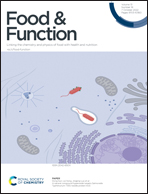Effect of the harvest period on the structure and anti-allergic activity of Porphyra haitanensis polysaccharides
Abstract
Polysaccharides are a major functional component of seaweeds with various biological activities. Porphyra haitanensis is usually harvested in different growth periods, but how the harvest periods influence the Porphyra haitanensis polysaccharide (PHP) activity is unclear. This work aimed to evaluate the anti-allergic activity of PHP from different harvest periods and investigate the potential structure–activity relationship. The water-soluble polysaccharide of P. haitanensis from three different harvest periods was purified and administered to an ovalbumin-sensitized food allergy mouse model. Results showed that PHPs significantly alleviated the allergic symptoms and reduced the production of histamine and allergen-specific IgE. Further experiments elucidated that PHPs suppressed the allergic activity of intestinal epithelial cells, dendritic cells, and Th2 cells and downregulated the proportion of Th2 cells. Noticeably, the molecular weight and sulfate content gradually decreased as the harvest period was delayed; simultaneously, the anti-allergic activity gradually increased, implying a relationship between the harvest period, structure, and anti-allergic activity of PHPs. This work elucidated the anti-allergic activity of PHPs from different harvest periods, facilitated the deep-processing and efficient application of Porphyra haitanensis, and shed light on the development of novel anti-allergic functional foods.



 Please wait while we load your content...
Please wait while we load your content...